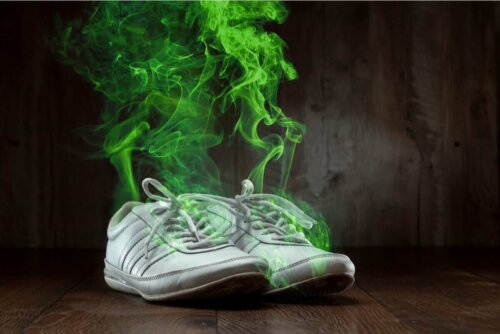What's the Cause of a Strong Body Odor?


Written and verified by the dermatologist Maria del Carmen Hernandez
Bromhidrosis is a common condition that seriously affects a person’s quality of life and a strong body odor is a characteristic symptom. That is a rather unpleasant odor that transmits strong non-verbal signals and is a source of social embarrassment for some people. It’s particularly bad when a person has selective anosmia — the inability to perceive the smell and, thus, is oblivious to it.
Perspiration itself has no stench. A foul smell only arises when the sweat comes in contact with the bacteria on the skin. People may treat or prevent it by changing their hygiene habits, although there are also medical options. There are more details about this condition below.
Causes of strong body odor (bromhidrosis)
According to studies in the International Journal of Cosmetic Science, bromhidrosis is due to the biotransformation of natural odorless secretions into volatile odorous molecules. Naturally, it’s associated with excessive sweating. In other words, the disorder appears more frequently in those who sweat more.
Microbiome concludes that Corynebacterium spp., in the resident microflora in the armpit, is important in this biotransformation. Obesity can also be a contributing factor to bromhidrosis. The background mechanism is the change these molecules undergo when metabolized by said microorganisms.

Causes of strong body odor
These are the two types of sweat glands and all human beings have them:
- Eccrine glands, located throughout the body
- Apocrine glands, located only in armpits, breasts, and groin region
The apocrine glands don’t activate until puberty. This is why strong body odor isn’t usually a problem among young children. It’s a sign of growth and development when it appears.
The interaction of secretion from the axillary apocrine sweat glands with bacteria, which generates unsaturated fatty acids that have a particular odor is an important mechanism. This odor must be present for someone to be diagnosed with bromhidrosis.
The bacterial metabolism of apocrine sweat is what generally causes odor. However, eccrine sweat can also be offensive. This second situation is usually triggered by the consumption of certain substances such as garlic and alcohol.
Find out How Anxiety Affects Your Body Odor
Prevention of strong body odor
There are many conservative treatment measures that patients who consult their family doctor for strong body odor already tried. However, medications and surgery are currently the most widely used approaches to bromhidrosis.
Surgery – sympathectomy
The most preferable method for bromhidrosis is surgery, although physicians reserve it for severe cases. However, postoperative complications and scars are common side effects in surgical treatments.
It’s most suitable for those patients who don’t respond to medical therapy and whose daily activities are significantly impacted by hyperhidrosis. According to studies by the Annals of Surgery, endoscopic thoracic sympathectomy is the last resort for therapeutic treatment of palmar, axillary, and craniofacial hyperhidrosis. It works by interrupting the fibers of the sympathetic nodes.
Botulinum Toxin
The main mechanism of action of the botulinum toxin for bromhidrosis is the inhibition of the release of acetylcholine from the sympathetic nerves that innervate the sweat eccrine glands. The treatment is effective on the palms of the hands and soles of the feet, although painful injections could be a limiting factor for some people.
The dose for intradermal injections depends on the area. For example, doctors use 50 to 100 units in the armpits. The main disadvantage of botulinum toxin treatment is that the effect only lasts a few months, so a person will require several applications in a year.
Antiperspirants with aluminum compounds
Most standard supermarket antiperspirants contain aluminum chloride. However, the more potent agents contain aluminum chlorohydrate. Agents with these substances inhibit the growth of malodorous bacteria.
These metal salts also reduce sweat by blocking the excretory ducts of the sweat glands, minimizing the water source that promotes bacterial growth. Topical therapy should be applied once a day, usually at night, when the skin is dry.

Learn how to make Five Natural Deodorants to Fight Body Odor
Recommendations for people with bromhidrosis
Both hyperhidrosis and bromhidrosis are common and distressing conditions as they complicate social activities. Sensitive management and appropriate referral can help minimize the impact on a patient’s quality of life, both individually and functionally.
Regular washing and underarm hair removal are helpful. Fragranced antiperspirants are first-line treatment in the management of body odor. This is because they reduce sweat volume and are also anti-bacterial.
All cited sources were thoroughly reviewed by our team to ensure their quality, reliability, currency, and validity. The bibliography of this article was considered reliable and of academic or scientific accuracy.
- Kanlayavattanakul M, Lourith N. Body malodours and their topical treatment agents. Int J Cosmet Sci. 2011;33(4):298-311. doi:10.1111/j.1468-2494.2011.00649.x
- Connolly M, de Berker D. Management of primary hyperhidrosis: a summary of the different treatment modalities. Am J Clin Dermatol. 2003;4(10):681-697. doi:10.2165/00128071-200304100-00003
- Herbst F, Plas EG, Függer R, Fritsch A. Endoscopic thoracic sympathectomy for primary hyperhidrosis of the upper limbs. A critical analysis and long-term results of 480 operations. Ann Surg. 1994;220(1):86-90. doi:10.1097/00000658-199407000-00012
- Li ZR, Sun CW, Zhang JY, Qi YQ, Hu JZ. Excision of apocrine glands with preservation of axillary superficial fascia for the treatment of axillary bromhidrosis. Dermatol Surg. 2015;41(5):640-644. doi:10.1097/DSS.0000000000000346
- Lam TH, Verzotto D, Brahma P, et al. Understanding the microbial basis of body odor in pre-pubescent children and teenagers. Microbiome. 2018;6(1):213. Published 2018 Nov 29. doi:10.1186/s40168-018-0588-z
- James AG, Hyliands D, Johnston H. Generation of volatile fatty acids by axillary bacteria. Int J Cosmet Sci. 2004;26(3):149-156. doi:10.1111/j.1467-2494.2004.00214.x
This text is provided for informational purposes only and does not replace consultation with a professional. If in doubt, consult your specialist.








